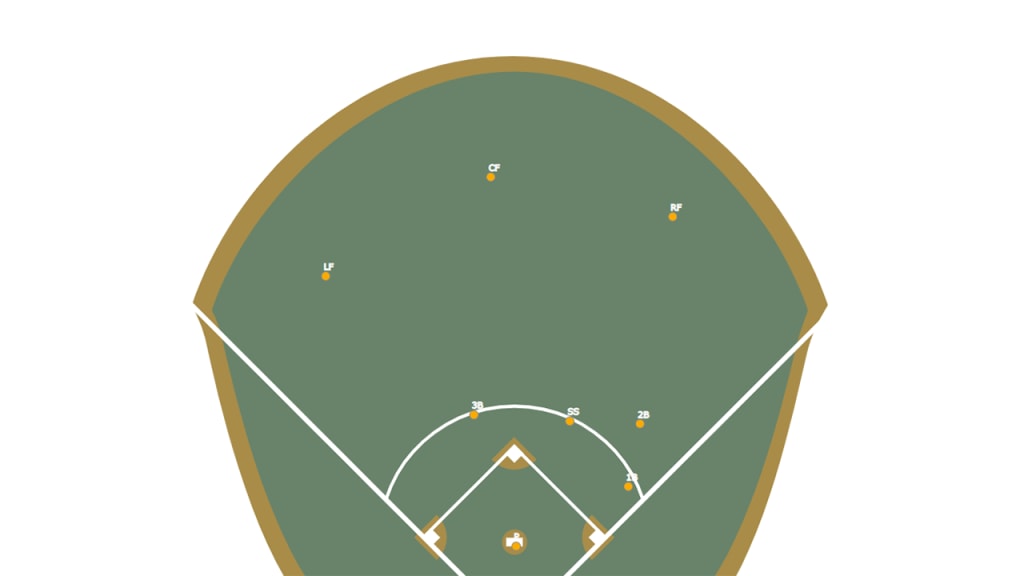The last time Chris Davis got a hit, the Orioles' manager was Buck Showalter. Dan Duquette was still the general manager. Adam Jones was in right field. It's been so long that another hitter with essentially the same name -- that'd be Oakland's Khris Davis -- has 16 homers since then, including two hit right in front of Chris in Baltimore on Thursday, not to mention two the night before.
It's been something of a baseball eternity, is the point, and after another hitless day (0-3 with a walk) in an 8-5 loss to Oakland on Thursday, Davis' futility streak is now up to 61 consecutive plate appearances, a Major League record, albeit not one anyone wants to own.
As you'd expect, it's hard to do something like this. Sure, it says a lot about the state of Davis' career right now, coming as it does off a rough .168/.243/.296 season in 2018, and the biggest issue is a lack of contact, as 30 of the 61 plate appearances have ended in a strikeout. (Seven more have been a walk or hit by pitch.) There isn't any explanation for this that doesn't start and end with a former All-Star going through just the most frustrating stretch anyone can think of, a painful burden he's been open about sharing.
Because of the strikeouts, his expected batting average (based on the usual outcomes of exit velocity and launch angle of a batted ball) in that time was a mere .129, so it's not like there's a terrible amount of under-performance here -- that's the lowest mark in the Majors since the streak began. But cutting out the strikeouts and walks, his expected batting average on balls in play is .293, which tells you that at least every now and then, a well-struck ball hasn't found green grass.
You can't go hitless in 61 plate appearances without bringing a great deal of struggle to the plate. You also can't pull that off without literally nothing going your way. This has never happened before, remember. You don't set marks like this without fortune failing to smile upon you.
Because remember, Davis has had batted-ball luck in his past. Here's a weakly hit dinker he hit last September with an .040 xBA, which means this type of ball lands for a hit about four percent of the time. Alex Gordon couldn't get to it. Single, Davis. Here's an .060 xBA grounder against the shift. Hit. Here's a .180 xBA ball that hit Chris Archer in the foot and bounced away. Hit. Here's a .380 xBA on a grounder that miraculously found its way through the shift. Hit.
Some of these are weird, unusual plays, but that's also the point, isn't it? Every player gets the benefit of those plays sometime -- but Davis hasn't. Nothing has fallen in. Nothing has gone right.
In that spirit, let's look at the five Davis batted balls during his streak that had the highest expected batting average, based on exit velocity and launch angle. (Note that this is about the quality of contact, so the location of the fielders is not considered.) His actual batting average during the stretch is .000, though you probably figured that out.
As a bonus, we can also find very similar batted balls that did fall for a hit. After all, Davis keeps coming so, so close.
1) .880 expected batting average: Sept. 22, 2018
109.2 mph / 12 degrees launch angle / 210 feet projected distance
These aren't all going to be about the shift, but this one is about the shift. No hitter in baseball has faced a shift as often as Davis has, more than 90 percent of the time since the start of 2018. Against the Yankees in September, Davis squared up a ball well, at 109.2 mph, and that usually leads to success. In 2018, the Majors hit .746 on balls hit 109 mph or harder.
But he didn't get it high enough off the ground, and Gleyber Torres was positioned 187 feet from the plate, so he needed to move all of six feet to get to it.
That ball can be a hit. It can be a double. Here's Derek Dietrich (109.0 mph / 12 degrees / launch angle / 213 feet projected distance) proving that last season. The defense wasn't shifted. It was hit slightly closer to the line. But it was a hit, for extra bases.
2) .680 expected batting average: April 3, 2019
105.0 mph / 19 degrees launch angle / 306 feet projected distance
Earlier this month, you might have thought that Davis had one. He hit it hard, and in the air, and in a way that it falls for a hit 68 percent of the time. You can see the video here, though it's not a terribly interesting watch, since right fielder Billy McKinney needed to go only 10 feet to catch it. Instead, it's more interesting to see how the Blue Jays were aligned. Sure, they were shifted over in the infield, but they were shifted to the left in the outfield, aligning with Davis' batted-ball data. That's how McKinney ended up right in right-center where he needed to be.

That, too, can be a hit. Here's Joey Votto (106.0 mph / 18 degrees launch angle / 302 feet projected distance) doing more or less the same thing, with a .670 expected average.
3) .670 expected batting average: March 31, 2019
102.0 mph / 32 degrees launch angle / 390 feet projected distance
This one, coming on a cold, 47-degree day with the wind blowing in (18 mph in from right field, to be exact) at Yankee Stadium is a good illustration of just how many things contribute to success or failure. It's never just about what the hitter does.
Davis hit this one reasonably well, all the way to the warning track at Yankee Stadium. The combination of a 102 mph exit velocity and a 32-degree launch angle is a hit nearly 70 percent of the time, but more important, when it is a hit, it's almost always a home run. Just look at the outcomes of that 102/32 combination over the last several years:

That's a home run so many times. That's a hit about two-thirds of the time, but the weather and the dimensions of Yankee Stadium kept the ball in the park. Look no further than this Brandon Lowe home run (101.6 mph / 32 degrees launch angle / 396 feet projected distance) to see what happens when a few extra feet helps push it just over the fence. Even the weather, it seems, was against Chris Davis.
4) .650 expected batting average: April 11, 2019, 2nd inning
105.1 mph / 18 degrees launch angle / 375 feet projected distance
This was going to be it. This was going to be the one. On Thursday afternoon, Davis stepped up and slammed a well-hit liner to center field. The infield was shifted, but the outfield wasn't. This wasn't really as hard as Ramon Laureano made it look, but this is still a ball that lands for a hit nearly two-thirds of the time. It's a quality hit.
Davis, to his credit, is putting a strong face on a difficult situation.

He's saying the right things, too, acknowledging the support of the Baltimore fan base.
Sometimes that ball does land, you know. Here's Leonys Martin last year (105.4 mph / 18 degrees launch angle / 389 feet projected distance) finding some green, in part due to the massive expanse of Comerica Park's deepest-in-baseball 420-foot center-field fence.
5) .610 expected batting average: April 6, 2019, 8th inning
100.2 mph / 7 degrees launch angle / 116 feet projected distance
It's worth noting how many of these have come in 2019, and how different they look from one another -- grounders, liners and flies. While Davis surely isn't making a great deal of contact, he's still hitting the ball reasonably hard, and this is the kind of hard-hit ground ball that ought to get through every now and then. And it does, over 60 percent of the time.
But not, of course, this time. Protecting a 6-4 lead with the bases loaded and two outs, the Yankees actually weren't shifting Davis, at least not in the "three infielders to one side of second base" definition we use. The shortstop was playing up the middle, just to the left of second base. The second baseman was in short right, and unfortunately for Davis, first baseman Greg Bird was in the exact right spot to collect this one. If he hadn't been, this wouldn't just have been a hit, it would have been a double, one that would have tied the game at worst and potentially given the Orioles a lead.
In fact, the closest comparable to this one -- Dietrich's 100.7 mph / 6 degree launch angle / 117 feet projected distance grounder in Miami last April -- was an extra-base hit. It was a triple. It wasn't terribly different at all from what Davis did.
Yet despite all that -- and an impressive-looking collection of exit velocities -- the streak continues. You have to figure that at some point soon, it will end. Maybe it will be a dribbler, or a crushed home run or even a bunt. (It won't be a bunt.)
Or maybe, just maybe, batted-ball luck will turn his way for a brief shining moment. After all, just remember what happened the last time he collected a hit, way back on Sept. 14 of last year. It came this close to being an out. Sometimes, that's all it takes.
